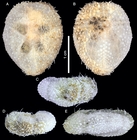
| Introduction | | Search taxa | | Taxon tree | | Specimens | | Attributes | | Literature | | Photo gallery | | Stats | | Log in |
Echinoidea taxon detailsCorparva lyrida Flores, Penchaszadeh & Brogger, 2021
1498239 (urn:lsid:marinespecies.org:taxname:1498239)
accepted
Species
marine,
recent only
Flores, J.N., Penchaszadeh, P.E. & Brogger, M.I. (2021). Heart urchins from the depths: Corparva lyrida gen. et sp. nov. (Palaeotropidae), and new records for the southwestern Atlantic Ocean. <em>Revista de Biología Tropical.</em> 69/ Suppl. 1: 14-34., available online at https://revistas.ucr.ac.cr/index.php/rbt/article/view/46320
page(s): 20-25; Figs 2A-E, 3A-E, 4A-F, 5A-L [details] Available for editors
Note Mar del Plata Canyon (38°06’34’’ S &...
From editor or global species database
Type locality Mar del Plata Canyon (38°06’34’’ S & 53°42’50’’ W), Argentine continental slope, 2950 m depth [details]
Type material Holotype: Museo Argentino de Ciencias Naturales “Bernardino Rivadavia” MACN-In 43280 (one half denuded specimen in ethanol 70 %, and external appendages mounted on three SEM stubs) - Holotype is the only specimen known [details]
Depth range Deep-sea context derived from a specimen depth data search
Depth range Deep-sea context derived from a specimen depth data search [details] Etymology lyrida refers to the April Lyrids, the meteor shower that occurs each year in the constellation Lyra. The specific name is...
Etymology lyrida refers to the April Lyrids, the meteor shower that occurs each year in the constellation Lyra. The specific name is a noun in apposition (feminine). [details]
Kroh, A.; Mooi, R. (2024). World Echinoidea Database. Corparva lyrida Flores, Penchaszadeh & Brogger, 2021. Accessed at: https://www.marinespecies.org/Echinoidea/aphia.php?p=taxdetails&id=1498239 on 2024-05-01
Date action by
original description
Flores, J.N., Penchaszadeh, P.E. & Brogger, M.I. (2021). Heart urchins from the depths: Corparva lyrida gen. et sp. nov. (Palaeotropidae), and new records for the southwestern Atlantic Ocean. <em>Revista de Biología Tropical.</em> 69/ Suppl. 1: 14-34., available online at https://revistas.ucr.ac.cr/index.php/rbt/article/view/46320
page(s): 20-25; Figs 2A-E, 3A-E, 4A-F, 5A-L [details] Available for editors context source (Deepsea) Flores, J.N., Penchaszadeh, P.E. & Brogger, M.I. (2021). Heart urchins from the depths: Corparva lyrida gen. et sp. nov. (Palaeotropidae), and new records for the southwestern Atlantic Ocean. <em>Revista de Biología Tropical.</em> 69/ Suppl. 1: 14-34., available online at https://revistas.ucr.ac.cr/index.php/rbt/article/view/46320 [details] Available for editors  Present Present  Inaccurate Inaccurate  Introduced: alien Introduced: alien  Containing type locality Containing type locality
From editor or global species database
Depth range Deep-sea context derived from a specimen depth data search [details]Diagnosis Test ovoid, small size, truncated posterior end. Semi-ethmolytic apical system, four gonopores. No frontal notch. Paired ambulacra apetaloid, pore-pairs small and rudimentary. Fascioles absent. Periproct on the posterior end, slightly inframarginal. Peristome D-shaped, sunken. Labrum narrow, not projecting over the peristome, reaching to rear part of second adjacent ambulacral plate. Plastron amphisternous, domed in profile. Primary spines slender, more abundant on aboral side, lacking on posterior ambulacral areas on oral side. Pedicellariae present: tridentate, globiferous, and triphyllous. [details] Etymology lyrida refers to the April Lyrids, the meteor shower that occurs each year in the constellation Lyra. The specific name is a noun in apposition (feminine). [details] Type locality Mar del Plata Canyon (38°06’34’’ S & 53°42’50’’ W), Argentine continental slope, 2950 m depth [details] Type material Holotype: Museo Argentino de Ciencias Naturales “Bernardino Rivadavia” MACN-In 43280 (one half denuded specimen in ethanol 70 %, and external appendages mounted on three SEM stubs) - Holotype is the only specimen known [details] |
